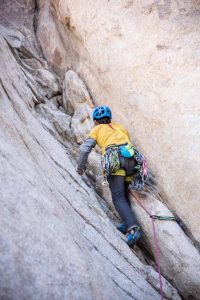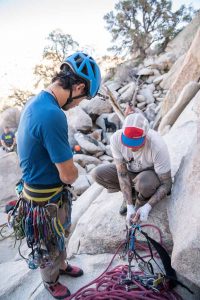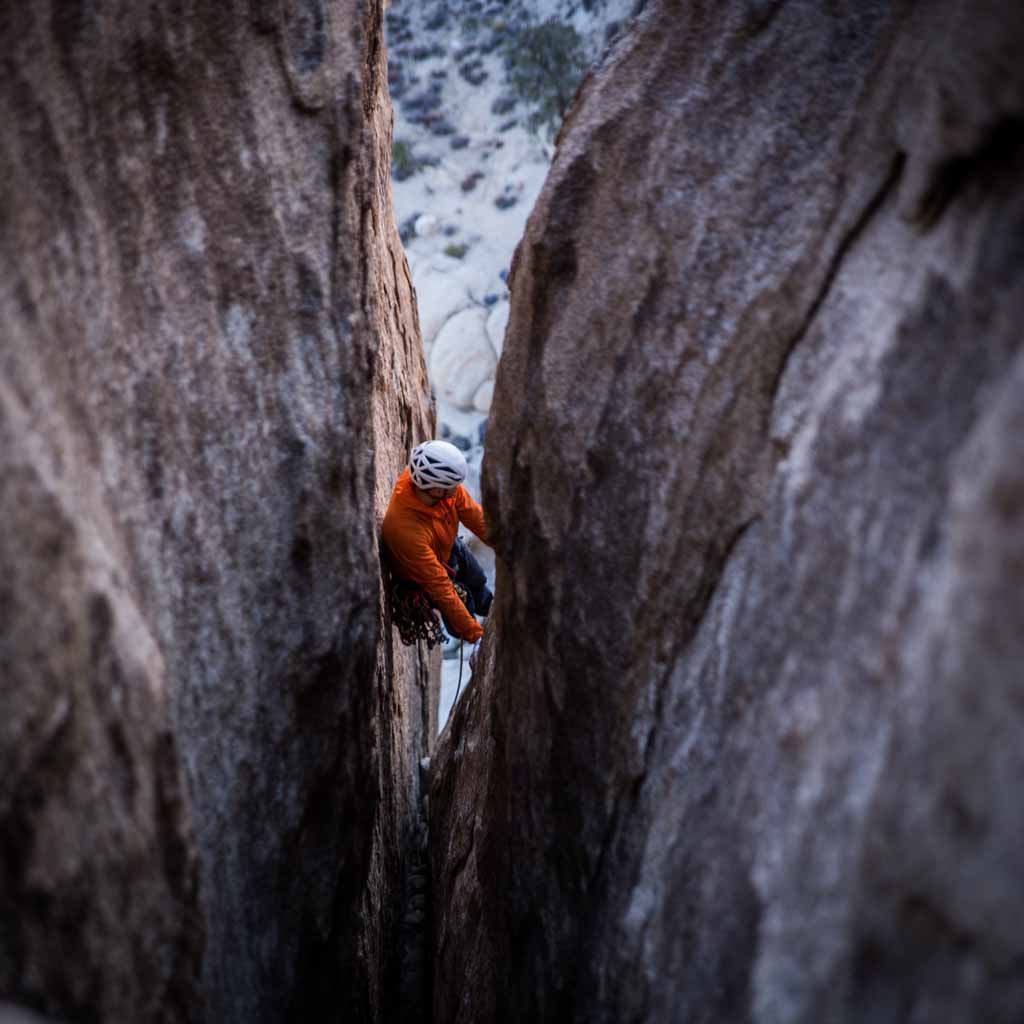Table of Contents
Redpoint, lead climbing, and “I have flashed this ” makes no sense to you?
Is this just gibberish, jargon and or maybe even something terrible?
Don’t worry, these are standard terms in climbing sports, such as golf handicap or a home run in baseball. It’s about how you approach a route and what “counts” as a successful approach.
You see, in climbing it’s all about how you approach and ascend a route because if it weren’t, you could just use a huge ladder and climb it to the top. What’s the difference between flash and onsight? Flash means someone gives you beta or tips or you watch another climber first and then try the route. Onsight means you come to the climbing route or Boulder and successfully climb it without any information about it beforehand.
Difference between flash and onsight
Let’s answer this really quick first, and a bit more in detail.
Flash and onsight are describing ways to approach a route. Both mean that you are of course lead climbing and able to successfully conquer the route on the first attempt. But they have an essential distinction:
Flash means you climb a route first try and you are allowed to get information about it. This information or “beta” as climbers call it, you can get both before and while you climb it. Beta comes from watching another climber, reading about the route, or even watching a video. It can also be from your buddy who gives you valuable bits about which hold works best, which moves you need. You can even have someone yell at you while you climb.
Onsight means you climb a route first try but you have no information, except where the route is, and the grade. You are not allowed to have any beta before and while you climb. And even the grade information is something where old-school climbers might disagree.
You only know what’s in the guidebook or topo guide. Onsighting a route is the king discipline of climbing. It’s also the most authentic test of your overallskills as a rock climber. So if you see someone you don’t know lead climbing a route, DON’T yell beta at them without them asking for it – you might destroy their onsight approach by accident.
This difference is not so crucial for bouldering usually, but it’s super vital to sport and traditional climbing. It’s safe to state that most tough routes are not onsighted but rather projected by climbers. By trying them multiple times, they develop information about it and even let other climbers guide them.
Technical Climbing
Technical climbing is a symbiosis of craftsmanship, courage, and engineering. Today there are only a few people who identify with technical climbing alone. Often it is used to conquer high walls in which due to weather conditions or lack of holds no free climbing is possible.
In technical climbing, there are five difficulty levels from A0 to A5, where the A stands for aid. A0 is basically a line with drilled hooks so close that you can just reach from one hook to the next and pull yourself up, without any danger. In contrast, if a passage rates A5, it means in case of a fall, all or most the safety gear that has been laid will probably come off and there is a real chance of dying.
Free climbing introduction
The craft of technical climbing had developed so far until the middle of the 20th century that you could climb every wall with just enough bolts. The adventure had died, and the upcoming free climbing heralded the end of this “Iron Age”.
In free climbing, you only use your hands and feet to move upwards using holds and footholds the rock offers. Free climbing itself doesn’t give any info about whether you use a rope and safety equipment.
So you are not using any technical gadgets to help you reach the top. Back in the day of technical climbing, technical was the only way most people climb, and the modern style of free climbing only started in the early 60s to become really popular.
But the idea of free-climbing had probably been around since at least the 19th century, and it always appeared elsewhere on the surface. An early advocate was Paul Preuss. The massive towering walls of the Alps, however, were mostly ascended by technical climbers and these guys trained for technical climbing in the local low mountain ranges, such as the Frankenjura or Palatinate.
Free climbing revolution
In the 1970s, the young Franke Kurt Albert traveled bored by the dying challenge in technical climbing in the US and Saxony. Saxon Switzerland, a mountainous area in eastern Germany, has had fixed rules of free climbing since the beginning of the century. The emigrated Saxon Fritz Wiessner also transferred these ideas from his homeland to his climbing activities in America, from which a free-climbing movement developed early on.
In the UK were also a lot of free climbers. Kurt Albert brought the idea of free-climbing back to the native Franconia. He began to climb technically-climbed routes in a free-climbing style and then marked them with a red dot.
Redpoint – Rotpunkt – the base of modern climbing sports
Kurt Albert later developed the red dot definition from this new style. It means that a route is considered to have been done successful if it is climbed in the lead and without using technical aid such as chains, hook, etc. The new style quickly became a worldwide standard and is known in the English-speaking world as “redpoint”.
Regardless of which free-climbing discipline one exercises, the red point of a route is always the goal. Only then is it considered to be “sent”. In the conversation among climbers, the term sending it is usually used, if one speaks of a redpoint ascent of a route.
The difference between free climbing, free solo, and free climbing
The terms free climbing and free solo are oftentimes lumped together, especially by journalists. So far, we know what free climbing is and that the term does not say anything about whether or not to secure the climbing with ropes and equipment.
You have to make a sharp distinction between free climbing and Free Solo. In Free Solo you practice free climbing, but it is deliberately without any belaying and safety equipment, aka your life depends on whether you can go through a climb without falling or not.
There are only very few climbers who practice Free Solo, but it is easy to understand and media loves it because it can have extreme fatal consequences. It’s probably the most medial discipline of climbing.
Lead climbing, Toprope and co. – free climbing styles
Anyone who climbs within redpoint definition and measures his performance in this realm is confronted with several possible types of access.
For most beginners the question arises before getting on each route: Lead climbing or instead Toprope? When leading you clip the rope when passing through safety points and climb up to the anchor (last hook) or climb up and leave the route from the top. In the event of a fall, you will end up on the previous safety point you clipped plus another length of any slack rope that may have been present. Which means you definitely take a fall and if you’re close to the ground there is a chance you might touch the ground.
When top-roping there is already a rope in the redirection, which hangs down to one. You’re basically a fish on the hook. Possible falls are therefore minimal. Beginners usually start with Toprope, and many climbers then develop the desire to climb routes in the lead. A toprope approach of a route doesn’t count as redpoint. Often you practice the movements and processes of challenging routes in Toprope before you approach them in the lead to pick up the redpoint.

Difference between Toprope and following (as second climber)
The terms Toprope and Following or “as second” are often used synonymously. The term “following” or as “second”, however, actually comes from alpine climbing, where a route usually has several pitches. The lead climber climbs up a rope length in the lead, attaches himself and secures the rope second in the climb up to him. Usually now the Follower or “second climber” increases the next length before and secures the second after up to himself.
The Difference between Flash and onsight in detail
Regardless of the discipline, be it sport climbing or traditional climbing, you can onsight and flash a redpoint style route or just go through them normally. I’ll now explain the difference between flash and onsight a bit more in detail.
Onsight
An onsight of a route is considered the supreme discipline in red poodle climbing.
Onsight can be translated as “at first sight”. This means that you do not have any further information before you successfully cross a route, except what you can see from the ground and imagine yourself, that could help you get through it.
This means, for example, the knowledge of the correct sequences of movements, special features of the handles, and reliable resting positions that you get when practicing a routes.
Before an onsight, you look closely at the route of desire, making certain assumptions on the handles and chalk marks and other factors, and then imagine how to climb the route. Depending on how much luck or experience you have these assumptions, and you can climb the route in the first attempt without prior knowledge, so onsight with sufficient strength and endurance.
You only have one try for an onsight. Sounds difficult? It is. That is why Onsight is also considered the most valuable way to visit a route. The heaviest onsights so far have been climbed by Alex Megos and Adam Ondras in grade 9a.
Of course, you can also just get into a route and hope to make the right decision by chance. This is the usual onsight approach, but you will not be able to achieve the same level of onsight as you would with proper preparation.
It is common to try every route that you would like to climb in onsight because “it could work”. In case of failure, the difficulties are then tinkered from hook to hook and then get the pass (just called redpoint or passage).
Flash
With a flash, you climb a route the same way you did on the first try, but with all the information you can get. You can watch other climbers in the route, question them about every detail, comb through Internet forums, and so on. You can really describe each handle and step exactly.
Of course, the only thing you can not do before a flash attempt is to get on the route and touch the handles yourself.
The flash of a route is given less value than an onsight, but the route has still been climbed in the first attempt. Therefore, a flash continues to be considered more valuable than a normal practiced via.
Sending it = Conquering a route redpoint style
If the onsight or flash of a route did not work out, you have to work out and rehearse it until you can go through it without falling.
The level of difficulty that you can achieve in Onsight and Flash is below the true maximum of their abilities for most climbers. This can be achieved by examining each movement, exercise, and planning the route.
Projecting routes
If you know enough and you think you could climb the route, you start climbing red dot attempts. Often you end up in the rope a couple of times until you finally manage to do it and send a tricky section of the climb.
This process is called projecting, and it is a mixture of nervous game, strategy, and fitness test.
Before the widespread adoption of the red dot definition, the views differed as to when a route was considered to have been made, depending on location and time.

Some old antiquated styles to make you smile
In the English-speaking world, the Yoyo style was the accepted doctrine before the red dot. It meant to climb freely but lay safety or clip existing hooks until you fell. Then you were immediately lowered to the ground. However, you left the rope for the next attempt in the already clipped safety points, so this part was now climbed Toprope. Studying or even closer examination of climbing routes were not allowed. A fall meant immediate lowering, and you just had to try again. This cycle was repeated until you arrived at the anchor or made it to the top and left the route.
By the way, when redpoint approaches started, there was also another accepted style of climbing a route called redcircling. Indicated by a red circle (in contrast to a filled redpoint), it meant you would climb free in the lead, but were allowed to sit in belay and rest. This concept is almost forgotten today. But it’s a nice reminder of the fact that ethics and styles of climbing change evolve and change over time.
A specialty: Headpoint in traditional climbing
In traditional climbing, there is a wide range of safety levels in the respective routes.
Some routes are littered with safety options, making it easy to lay gear everywhere, and some are infamous for having sections where a fall will be fatal even when safety has been laid, due to the fact that the rock is unstable, etc, and as soon as one friend or nut comes off it will start a domino of flying safeties.Sounds crazy to climb a route where you can seriously hurt yourself? For many, that’s just the attraction. Completely controlling your own situation and knowing that you will not fall.
So how do you proceed? Head Point!
Headpoint means the extensive practicing of a traditional route in Toprope until you are so confident in the lead that you can safely lay gear without falling during the most difficult sections. It’s basically safety by practicing climbing instead of drilling and placing sport climbing hooks. Interesting concept, right?
Conclusion
That’s it, we covered most of the critical styles of climbing in modern rock climbing, explaining the difference between flash and onsight as well. I hope you liked this article, feel free to have a look at other articles such as my guide for bouldering training and rock climbing endurance or even some advise on how to find the right climbing pants.
And if you love my site, subscribe and get informed when fresh articles are released, I promise no spam!

